Analysis of Negative Externalities: Case Studies and Solutions
VerifiedAdded on 2022/12/23
|12
|3794
|88
Essay
AI Summary
This essay delves into the concept of negative externalities, also known as external costs, which are the indirect impacts of economic transactions on third parties. It explains the need for government intervention, detailing the use of taxes, charges, and regulations to correct these externalities, along with their respective advantages and disadvantages, supported by real-life examples. The essay then presents a case study, likely from the author's home country, to illustrate the effects of an externality on market outcomes, including deadweight loss, and discusses the government's approach to addressing the issue. Furthermore, it suggests alternative options for managing the negative externalities in the case study and identifies the relevant market structure based on its key characteristics. The essay concludes with an analysis of market structures and their implications, providing a comprehensive overview of negative externalities and their economic consequences, utilizing various graphs and case studies to support the arguments. The essay showcases the impact of negative externalities on the environment, tourism, and the economy as a whole.

ACCOUNTING THEORY
2019
2019
Paraphrase This Document
Need a fresh take? Get an instant paraphrase of this document with our AI Paraphraser
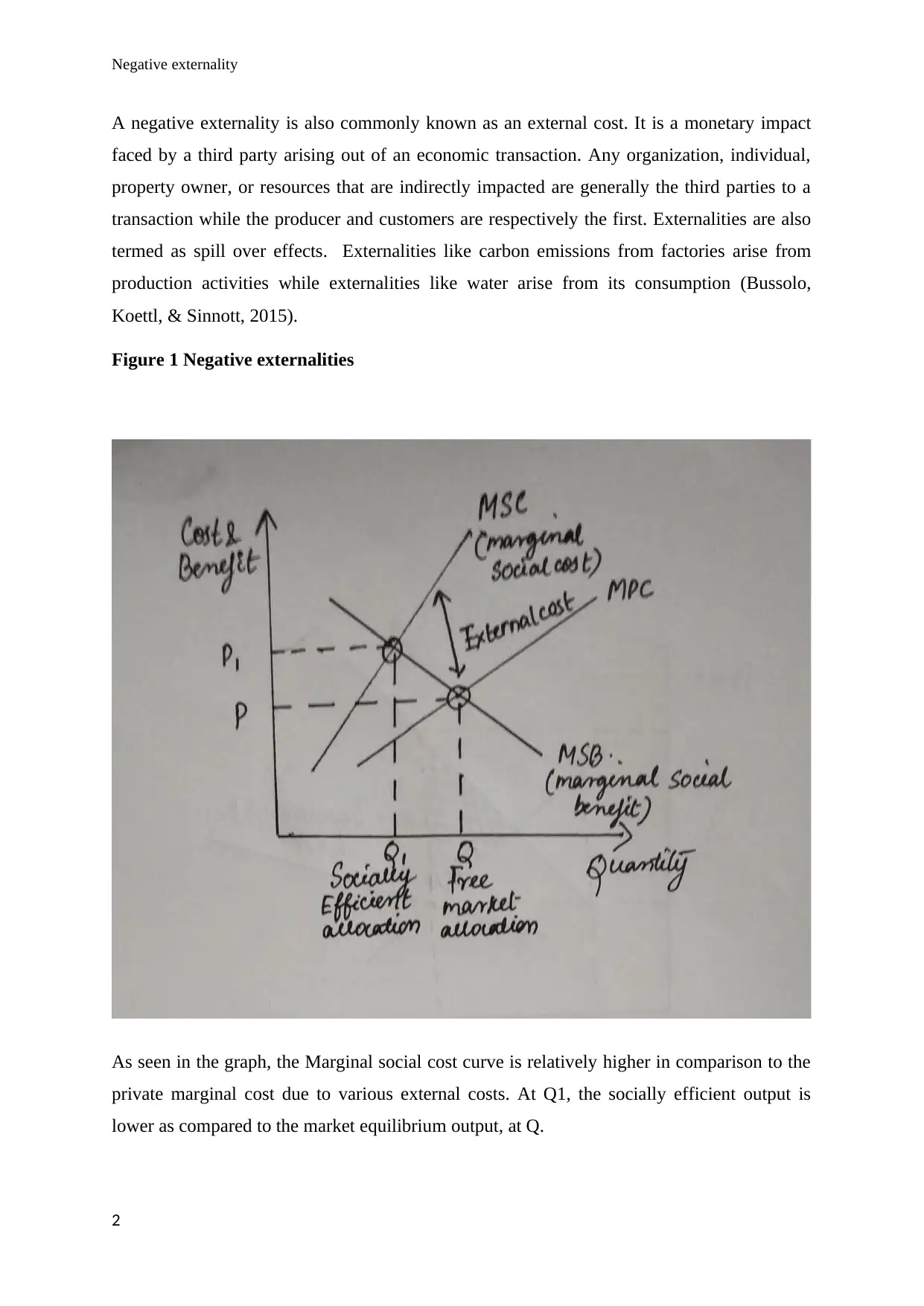
Negative externality
A negative externality is also commonly known as an external cost. It is a monetary impact
faced by a third party arising out of an economic transaction. Any organization, individual,
property owner, or resources that are indirectly impacted are generally the third parties to a
transaction while the producer and customers are respectively the first. Externalities are also
termed as spill over effects. Externalities like carbon emissions from factories arise from
production activities while externalities like water arise from its consumption (Bussolo,
Koettl, & Sinnott, 2015).
Figure 1 Negative externalities
As seen in the graph, the Marginal social cost curve is relatively higher in comparison to the
private marginal cost due to various external costs. At Q1, the socially efficient output is
lower as compared to the market equilibrium output, at Q.
2
A negative externality is also commonly known as an external cost. It is a monetary impact
faced by a third party arising out of an economic transaction. Any organization, individual,
property owner, or resources that are indirectly impacted are generally the third parties to a
transaction while the producer and customers are respectively the first. Externalities are also
termed as spill over effects. Externalities like carbon emissions from factories arise from
production activities while externalities like water arise from its consumption (Bussolo,
Koettl, & Sinnott, 2015).
Figure 1 Negative externalities
As seen in the graph, the Marginal social cost curve is relatively higher in comparison to the
private marginal cost due to various external costs. At Q1, the socially efficient output is
lower as compared to the market equilibrium output, at Q.
2
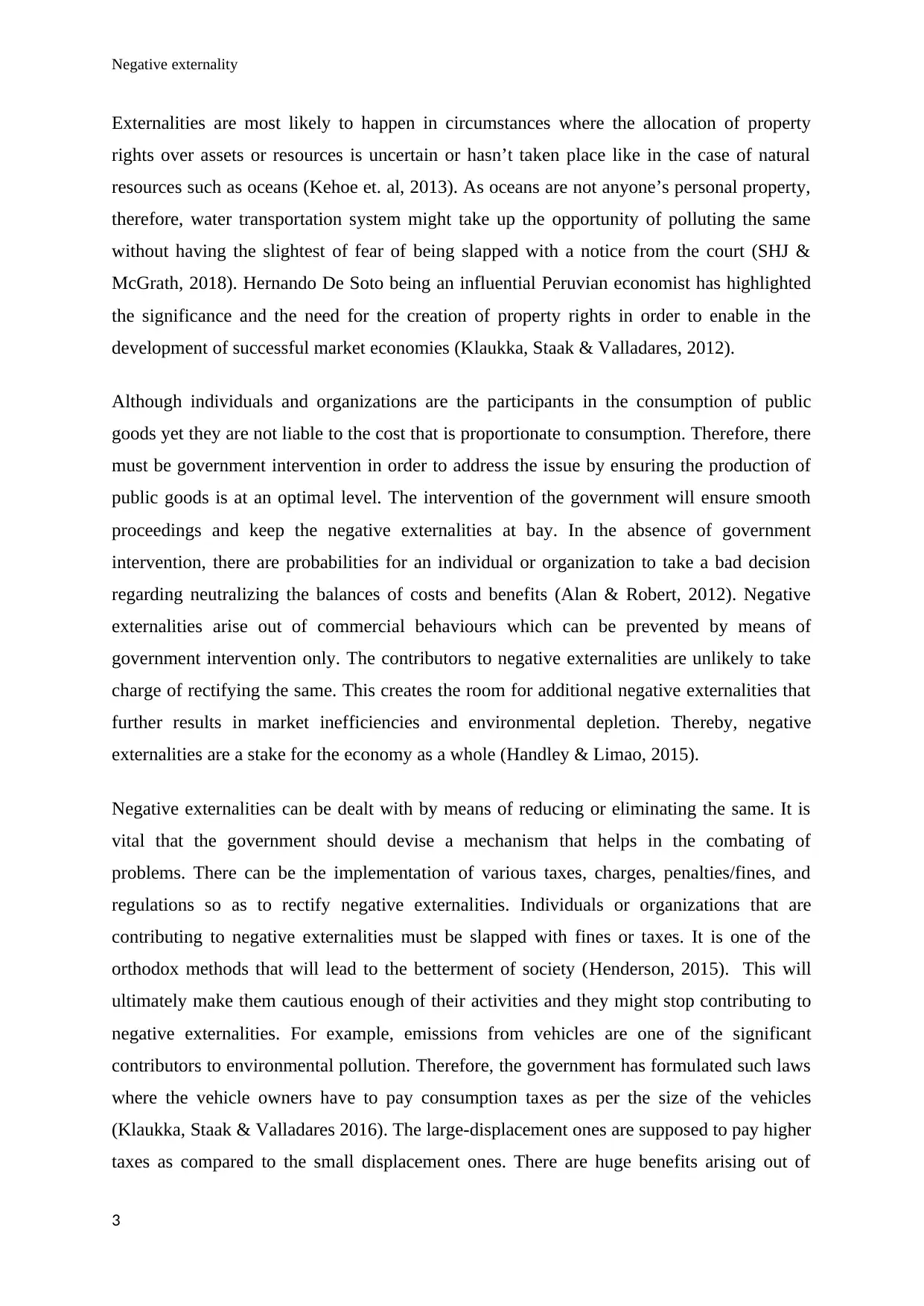
Negative externality
Externalities are most likely to happen in circumstances where the allocation of property
rights over assets or resources is uncertain or hasn’t taken place like in the case of natural
resources such as oceans (Kehoe et. al, 2013). As oceans are not anyone’s personal property,
therefore, water transportation system might take up the opportunity of polluting the same
without having the slightest of fear of being slapped with a notice from the court (SHJ &
McGrath, 2018). Hernando De Soto being an influential Peruvian economist has highlighted
the significance and the need for the creation of property rights in order to enable in the
development of successful market economies (Klaukka, Staak & Valladares, 2012).
Although individuals and organizations are the participants in the consumption of public
goods yet they are not liable to the cost that is proportionate to consumption. Therefore, there
must be government intervention in order to address the issue by ensuring the production of
public goods is at an optimal level. The intervention of the government will ensure smooth
proceedings and keep the negative externalities at bay. In the absence of government
intervention, there are probabilities for an individual or organization to take a bad decision
regarding neutralizing the balances of costs and benefits (Alan & Robert, 2012). Negative
externalities arise out of commercial behaviours which can be prevented by means of
government intervention only. The contributors to negative externalities are unlikely to take
charge of rectifying the same. This creates the room for additional negative externalities that
further results in market inefficiencies and environmental depletion. Thereby, negative
externalities are a stake for the economy as a whole (Handley & Limao, 2015).
Negative externalities can be dealt with by means of reducing or eliminating the same. It is
vital that the government should devise a mechanism that helps in the combating of
problems. There can be the implementation of various taxes, charges, penalties/fines, and
regulations so as to rectify negative externalities. Individuals or organizations that are
contributing to negative externalities must be slapped with fines or taxes. It is one of the
orthodox methods that will lead to the betterment of society (Henderson, 2015). This will
ultimately make them cautious enough of their activities and they might stop contributing to
negative externalities. For example, emissions from vehicles are one of the significant
contributors to environmental pollution. Therefore, the government has formulated such laws
where the vehicle owners have to pay consumption taxes as per the size of the vehicles
(Klaukka, Staak & Valladares 2016). The large-displacement ones are supposed to pay higher
taxes as compared to the small displacement ones. There are huge benefits arising out of
3
Externalities are most likely to happen in circumstances where the allocation of property
rights over assets or resources is uncertain or hasn’t taken place like in the case of natural
resources such as oceans (Kehoe et. al, 2013). As oceans are not anyone’s personal property,
therefore, water transportation system might take up the opportunity of polluting the same
without having the slightest of fear of being slapped with a notice from the court (SHJ &
McGrath, 2018). Hernando De Soto being an influential Peruvian economist has highlighted
the significance and the need for the creation of property rights in order to enable in the
development of successful market economies (Klaukka, Staak & Valladares, 2012).
Although individuals and organizations are the participants in the consumption of public
goods yet they are not liable to the cost that is proportionate to consumption. Therefore, there
must be government intervention in order to address the issue by ensuring the production of
public goods is at an optimal level. The intervention of the government will ensure smooth
proceedings and keep the negative externalities at bay. In the absence of government
intervention, there are probabilities for an individual or organization to take a bad decision
regarding neutralizing the balances of costs and benefits (Alan & Robert, 2012). Negative
externalities arise out of commercial behaviours which can be prevented by means of
government intervention only. The contributors to negative externalities are unlikely to take
charge of rectifying the same. This creates the room for additional negative externalities that
further results in market inefficiencies and environmental depletion. Thereby, negative
externalities are a stake for the economy as a whole (Handley & Limao, 2015).
Negative externalities can be dealt with by means of reducing or eliminating the same. It is
vital that the government should devise a mechanism that helps in the combating of
problems. There can be the implementation of various taxes, charges, penalties/fines, and
regulations so as to rectify negative externalities. Individuals or organizations that are
contributing to negative externalities must be slapped with fines or taxes. It is one of the
orthodox methods that will lead to the betterment of society (Henderson, 2015). This will
ultimately make them cautious enough of their activities and they might stop contributing to
negative externalities. For example, emissions from vehicles are one of the significant
contributors to environmental pollution. Therefore, the government has formulated such laws
where the vehicle owners have to pay consumption taxes as per the size of the vehicles
(Klaukka, Staak & Valladares 2016). The large-displacement ones are supposed to pay higher
taxes as compared to the small displacement ones. There are huge benefits arising out of
3
⊘ This is a preview!⊘
Do you want full access?
Subscribe today to unlock all pages.

Trusted by 1+ million students worldwide
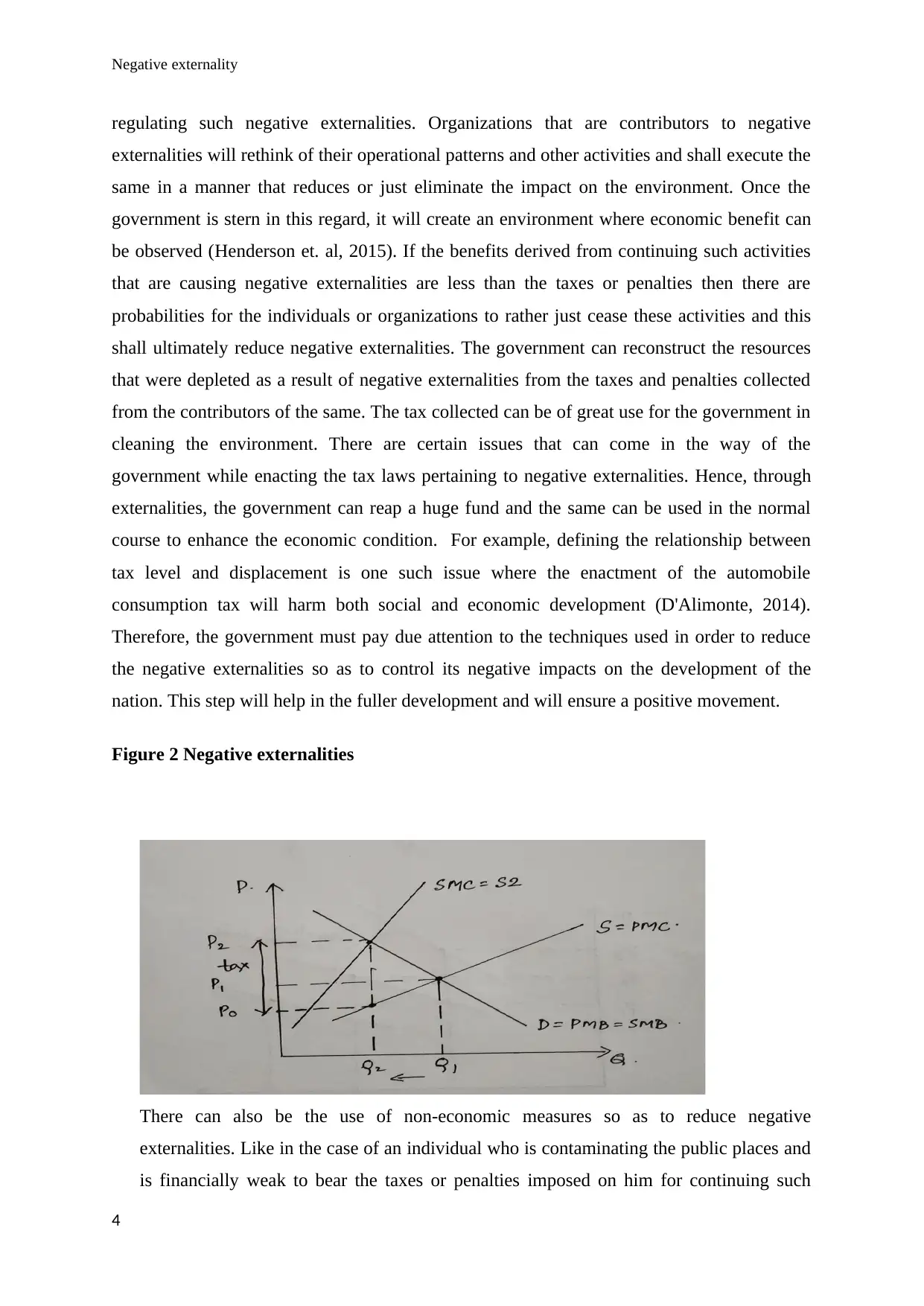
Negative externality
regulating such negative externalities. Organizations that are contributors to negative
externalities will rethink of their operational patterns and other activities and shall execute the
same in a manner that reduces or just eliminate the impact on the environment. Once the
government is stern in this regard, it will create an environment where economic benefit can
be observed (Henderson et. al, 2015). If the benefits derived from continuing such activities
that are causing negative externalities are less than the taxes or penalties then there are
probabilities for the individuals or organizations to rather just cease these activities and this
shall ultimately reduce negative externalities. The government can reconstruct the resources
that were depleted as a result of negative externalities from the taxes and penalties collected
from the contributors of the same. The tax collected can be of great use for the government in
cleaning the environment. There are certain issues that can come in the way of the
government while enacting the tax laws pertaining to negative externalities. Hence, through
externalities, the government can reap a huge fund and the same can be used in the normal
course to enhance the economic condition. For example, defining the relationship between
tax level and displacement is one such issue where the enactment of the automobile
consumption tax will harm both social and economic development (D'Alimonte, 2014).
Therefore, the government must pay due attention to the techniques used in order to reduce
the negative externalities so as to control its negative impacts on the development of the
nation. This step will help in the fuller development and will ensure a positive movement.
Figure 2 Negative externalities
There can also be the use of non-economic measures so as to reduce negative
externalities. Like in the case of an individual who is contaminating the public places and
is financially weak to bear the taxes or penalties imposed on him for continuing such
4
regulating such negative externalities. Organizations that are contributors to negative
externalities will rethink of their operational patterns and other activities and shall execute the
same in a manner that reduces or just eliminate the impact on the environment. Once the
government is stern in this regard, it will create an environment where economic benefit can
be observed (Henderson et. al, 2015). If the benefits derived from continuing such activities
that are causing negative externalities are less than the taxes or penalties then there are
probabilities for the individuals or organizations to rather just cease these activities and this
shall ultimately reduce negative externalities. The government can reconstruct the resources
that were depleted as a result of negative externalities from the taxes and penalties collected
from the contributors of the same. The tax collected can be of great use for the government in
cleaning the environment. There are certain issues that can come in the way of the
government while enacting the tax laws pertaining to negative externalities. Hence, through
externalities, the government can reap a huge fund and the same can be used in the normal
course to enhance the economic condition. For example, defining the relationship between
tax level and displacement is one such issue where the enactment of the automobile
consumption tax will harm both social and economic development (D'Alimonte, 2014).
Therefore, the government must pay due attention to the techniques used in order to reduce
the negative externalities so as to control its negative impacts on the development of the
nation. This step will help in the fuller development and will ensure a positive movement.
Figure 2 Negative externalities
There can also be the use of non-economic measures so as to reduce negative
externalities. Like in the case of an individual who is contaminating the public places and
is financially weak to bear the taxes or penalties imposed on him for continuing such
4
Paraphrase This Document
Need a fresh take? Get an instant paraphrase of this document with our AI Paraphraser
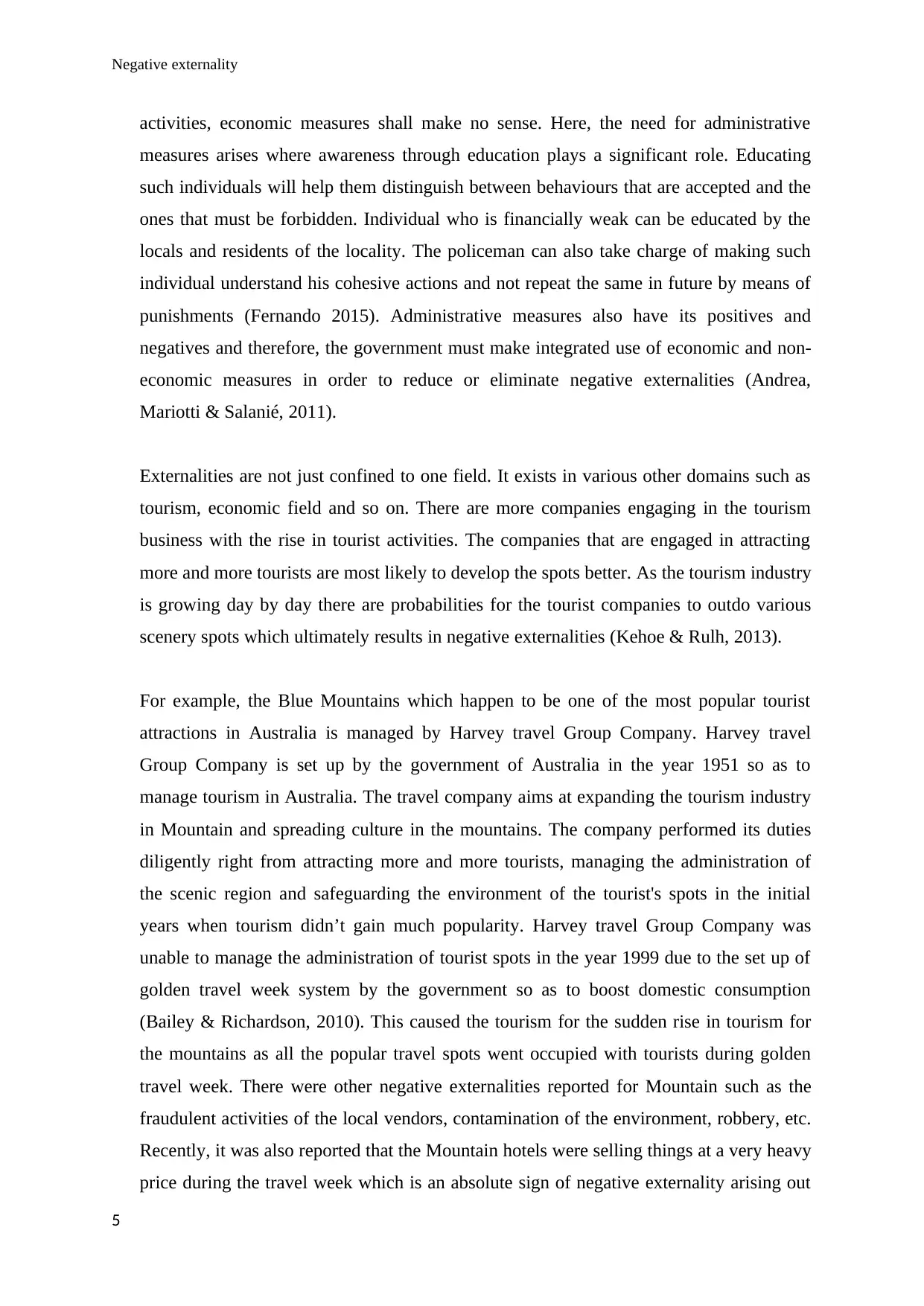
Negative externality
activities, economic measures shall make no sense. Here, the need for administrative
measures arises where awareness through education plays a significant role. Educating
such individuals will help them distinguish between behaviours that are accepted and the
ones that must be forbidden. Individual who is financially weak can be educated by the
locals and residents of the locality. The policeman can also take charge of making such
individual understand his cohesive actions and not repeat the same in future by means of
punishments (Fernando 2015). Administrative measures also have its positives and
negatives and therefore, the government must make integrated use of economic and non-
economic measures in order to reduce or eliminate negative externalities (Andrea,
Mariotti & Salanié, 2011).
Externalities are not just confined to one field. It exists in various other domains such as
tourism, economic field and so on. There are more companies engaging in the tourism
business with the rise in tourist activities. The companies that are engaged in attracting
more and more tourists are most likely to develop the spots better. As the tourism industry
is growing day by day there are probabilities for the tourist companies to outdo various
scenery spots which ultimately results in negative externalities (Kehoe & Rulh, 2013).
For example, the Blue Mountains which happen to be one of the most popular tourist
attractions in Australia is managed by Harvey travel Group Company. Harvey travel
Group Company is set up by the government of Australia in the year 1951 so as to
manage tourism in Australia. The travel company aims at expanding the tourism industry
in Mountain and spreading culture in the mountains. The company performed its duties
diligently right from attracting more and more tourists, managing the administration of
the scenic region and safeguarding the environment of the tourist's spots in the initial
years when tourism didn’t gain much popularity. Harvey travel Group Company was
unable to manage the administration of tourist spots in the year 1999 due to the set up of
golden travel week system by the government so as to boost domestic consumption
(Bailey & Richardson, 2010). This caused the tourism for the sudden rise in tourism for
the mountains as all the popular travel spots went occupied with tourists during golden
travel week. There were other negative externalities reported for Mountain such as the
fraudulent activities of the local vendors, contamination of the environment, robbery, etc.
Recently, it was also reported that the Mountain hotels were selling things at a very heavy
price during the travel week which is an absolute sign of negative externality arising out
5
activities, economic measures shall make no sense. Here, the need for administrative
measures arises where awareness through education plays a significant role. Educating
such individuals will help them distinguish between behaviours that are accepted and the
ones that must be forbidden. Individual who is financially weak can be educated by the
locals and residents of the locality. The policeman can also take charge of making such
individual understand his cohesive actions and not repeat the same in future by means of
punishments (Fernando 2015). Administrative measures also have its positives and
negatives and therefore, the government must make integrated use of economic and non-
economic measures in order to reduce or eliminate negative externalities (Andrea,
Mariotti & Salanié, 2011).
Externalities are not just confined to one field. It exists in various other domains such as
tourism, economic field and so on. There are more companies engaging in the tourism
business with the rise in tourist activities. The companies that are engaged in attracting
more and more tourists are most likely to develop the spots better. As the tourism industry
is growing day by day there are probabilities for the tourist companies to outdo various
scenery spots which ultimately results in negative externalities (Kehoe & Rulh, 2013).
For example, the Blue Mountains which happen to be one of the most popular tourist
attractions in Australia is managed by Harvey travel Group Company. Harvey travel
Group Company is set up by the government of Australia in the year 1951 so as to
manage tourism in Australia. The travel company aims at expanding the tourism industry
in Mountain and spreading culture in the mountains. The company performed its duties
diligently right from attracting more and more tourists, managing the administration of
the scenic region and safeguarding the environment of the tourist's spots in the initial
years when tourism didn’t gain much popularity. Harvey travel Group Company was
unable to manage the administration of tourist spots in the year 1999 due to the set up of
golden travel week system by the government so as to boost domestic consumption
(Bailey & Richardson, 2010). This caused the tourism for the sudden rise in tourism for
the mountains as all the popular travel spots went occupied with tourists during golden
travel week. There were other negative externalities reported for Mountain such as the
fraudulent activities of the local vendors, contamination of the environment, robbery, etc.
Recently, it was also reported that the Mountain hotels were selling things at a very heavy
price during the travel week which is an absolute sign of negative externality arising out
5
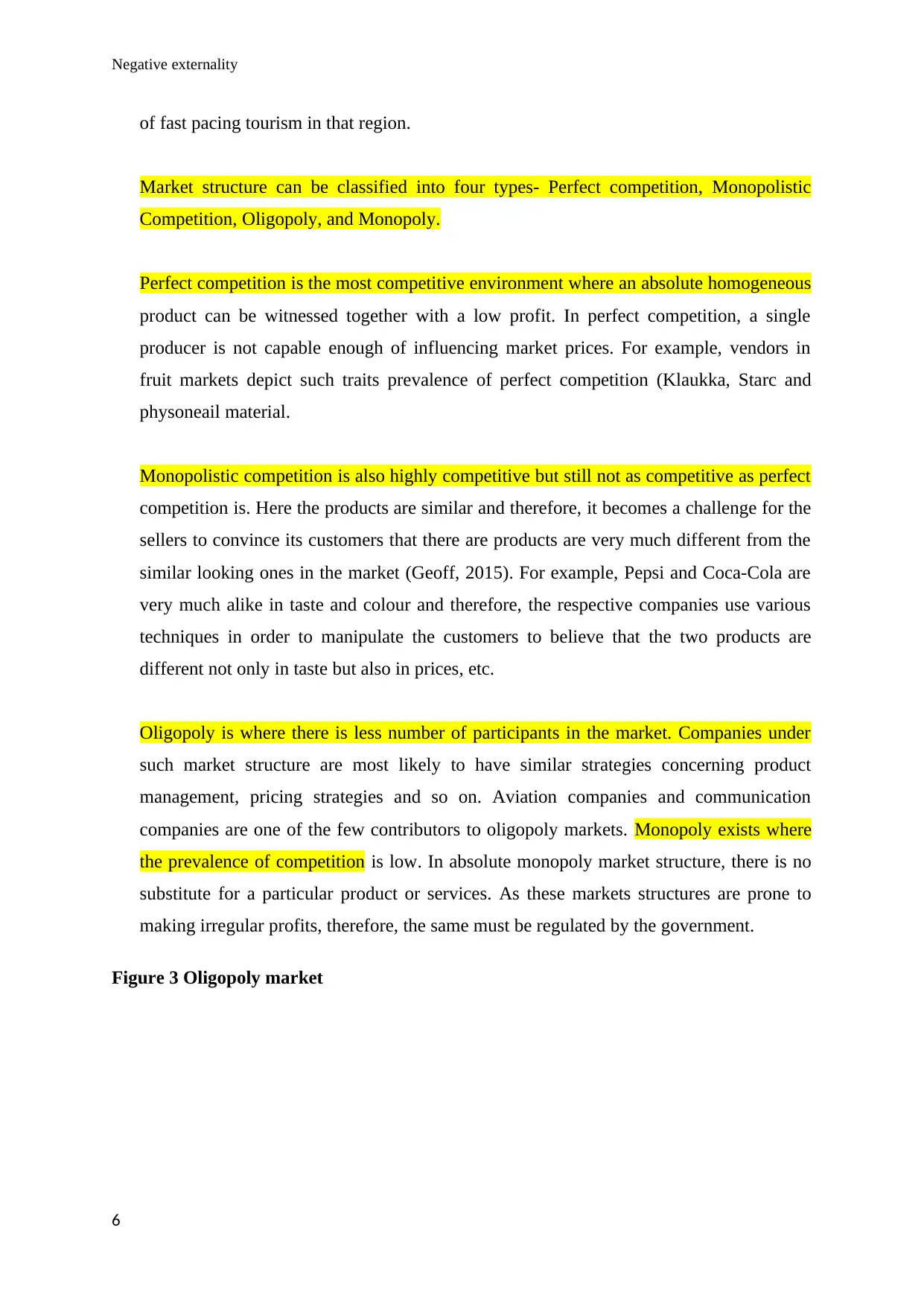
Negative externality
of fast pacing tourism in that region.
Market structure can be classified into four types- Perfect competition, Monopolistic
Competition, Oligopoly, and Monopoly.
Perfect competition is the most competitive environment where an absolute homogeneous
product can be witnessed together with a low profit. In perfect competition, a single
producer is not capable enough of influencing market prices. For example, vendors in
fruit markets depict such traits prevalence of perfect competition (Klaukka, Starc and
physoneail material.
Monopolistic competition is also highly competitive but still not as competitive as perfect
competition is. Here the products are similar and therefore, it becomes a challenge for the
sellers to convince its customers that there are products are very much different from the
similar looking ones in the market (Geoff, 2015). For example, Pepsi and Coca-Cola are
very much alike in taste and colour and therefore, the respective companies use various
techniques in order to manipulate the customers to believe that the two products are
different not only in taste but also in prices, etc.
Oligopoly is where there is less number of participants in the market. Companies under
such market structure are most likely to have similar strategies concerning product
management, pricing strategies and so on. Aviation companies and communication
companies are one of the few contributors to oligopoly markets. Monopoly exists where
the prevalence of competition is low. In absolute monopoly market structure, there is no
substitute for a particular product or services. As these markets structures are prone to
making irregular profits, therefore, the same must be regulated by the government.
Figure 3 Oligopoly market
6
of fast pacing tourism in that region.
Market structure can be classified into four types- Perfect competition, Monopolistic
Competition, Oligopoly, and Monopoly.
Perfect competition is the most competitive environment where an absolute homogeneous
product can be witnessed together with a low profit. In perfect competition, a single
producer is not capable enough of influencing market prices. For example, vendors in
fruit markets depict such traits prevalence of perfect competition (Klaukka, Starc and
physoneail material.
Monopolistic competition is also highly competitive but still not as competitive as perfect
competition is. Here the products are similar and therefore, it becomes a challenge for the
sellers to convince its customers that there are products are very much different from the
similar looking ones in the market (Geoff, 2015). For example, Pepsi and Coca-Cola are
very much alike in taste and colour and therefore, the respective companies use various
techniques in order to manipulate the customers to believe that the two products are
different not only in taste but also in prices, etc.
Oligopoly is where there is less number of participants in the market. Companies under
such market structure are most likely to have similar strategies concerning product
management, pricing strategies and so on. Aviation companies and communication
companies are one of the few contributors to oligopoly markets. Monopoly exists where
the prevalence of competition is low. In absolute monopoly market structure, there is no
substitute for a particular product or services. As these markets structures are prone to
making irregular profits, therefore, the same must be regulated by the government.
Figure 3 Oligopoly market
6
⊘ This is a preview!⊘
Do you want full access?
Subscribe today to unlock all pages.

Trusted by 1+ million students worldwide
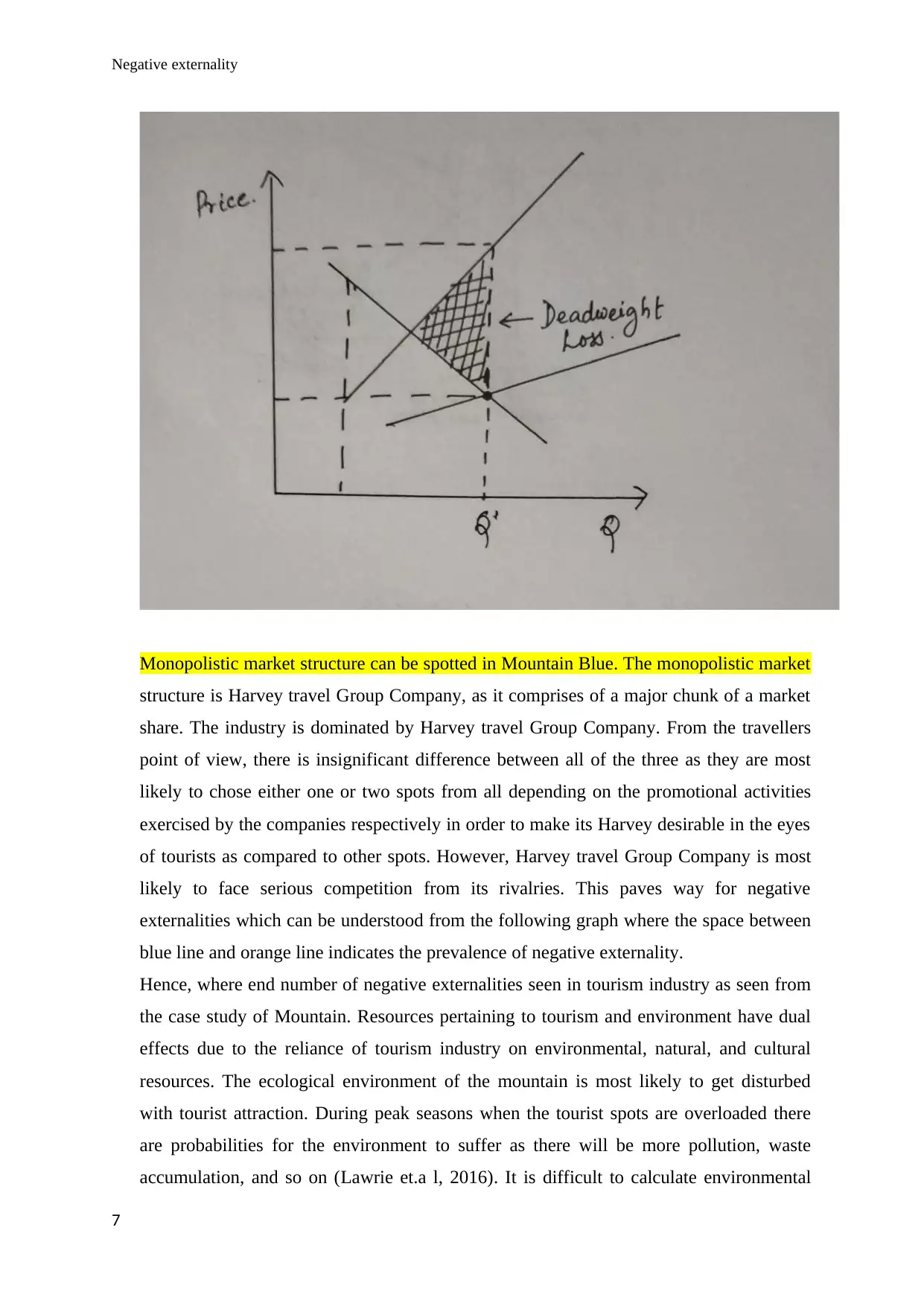
Negative externality
Monopolistic market structure can be spotted in Mountain Blue. The monopolistic market
structure is Harvey travel Group Company, as it comprises of a major chunk of a market
share. The industry is dominated by Harvey travel Group Company. From the travellers
point of view, there is insignificant difference between all of the three as they are most
likely to chose either one or two spots from all depending on the promotional activities
exercised by the companies respectively in order to make its Harvey desirable in the eyes
of tourists as compared to other spots. However, Harvey travel Group Company is most
likely to face serious competition from its rivalries. This paves way for negative
externalities which can be understood from the following graph where the space between
blue line and orange line indicates the prevalence of negative externality.
Hence, where end number of negative externalities seen in tourism industry as seen from
the case study of Mountain. Resources pertaining to tourism and environment have dual
effects due to the reliance of tourism industry on environmental, natural, and cultural
resources. The ecological environment of the mountain is most likely to get disturbed
with tourist attraction. During peak seasons when the tourist spots are overloaded there
are probabilities for the environment to suffer as there will be more pollution, waste
accumulation, and so on (Lawrie et.a l, 2016). It is difficult to calculate environmental
7
Monopolistic market structure can be spotted in Mountain Blue. The monopolistic market
structure is Harvey travel Group Company, as it comprises of a major chunk of a market
share. The industry is dominated by Harvey travel Group Company. From the travellers
point of view, there is insignificant difference between all of the three as they are most
likely to chose either one or two spots from all depending on the promotional activities
exercised by the companies respectively in order to make its Harvey desirable in the eyes
of tourists as compared to other spots. However, Harvey travel Group Company is most
likely to face serious competition from its rivalries. This paves way for negative
externalities which can be understood from the following graph where the space between
blue line and orange line indicates the prevalence of negative externality.
Hence, where end number of negative externalities seen in tourism industry as seen from
the case study of Mountain. Resources pertaining to tourism and environment have dual
effects due to the reliance of tourism industry on environmental, natural, and cultural
resources. The ecological environment of the mountain is most likely to get disturbed
with tourist attraction. During peak seasons when the tourist spots are overloaded there
are probabilities for the environment to suffer as there will be more pollution, waste
accumulation, and so on (Lawrie et.a l, 2016). It is difficult to calculate environmental
7
Paraphrase This Document
Need a fresh take? Get an instant paraphrase of this document with our AI Paraphraser
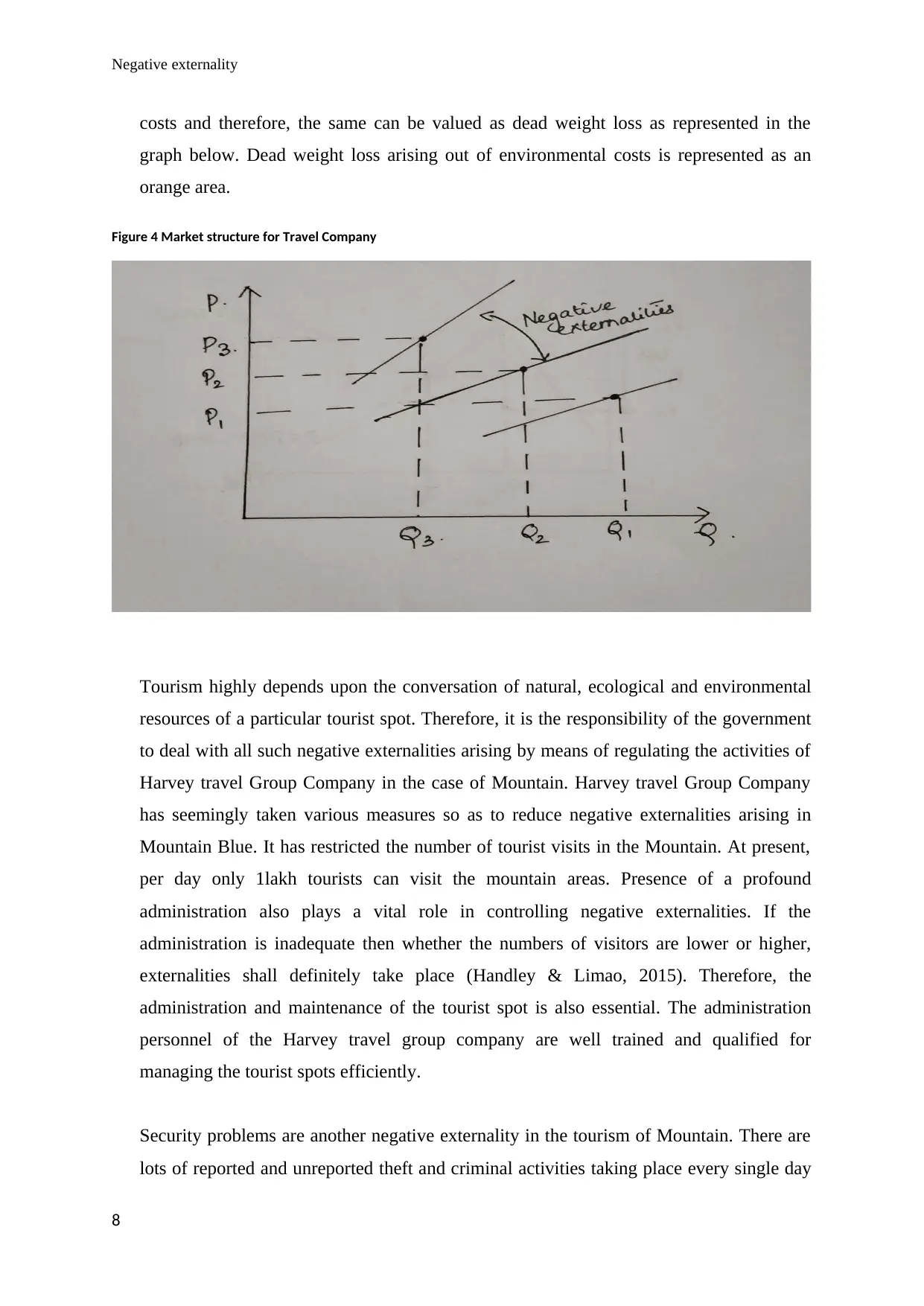
Negative externality
costs and therefore, the same can be valued as dead weight loss as represented in the
graph below. Dead weight loss arising out of environmental costs is represented as an
orange area.
Figure 4 Market structure for Travel Company
Tourism highly depends upon the conversation of natural, ecological and environmental
resources of a particular tourist spot. Therefore, it is the responsibility of the government
to deal with all such negative externalities arising by means of regulating the activities of
Harvey travel Group Company in the case of Mountain. Harvey travel Group Company
has seemingly taken various measures so as to reduce negative externalities arising in
Mountain Blue. It has restricted the number of tourist visits in the Mountain. At present,
per day only 1lakh tourists can visit the mountain areas. Presence of a profound
administration also plays a vital role in controlling negative externalities. If the
administration is inadequate then whether the numbers of visitors are lower or higher,
externalities shall definitely take place (Handley & Limao, 2015). Therefore, the
administration and maintenance of the tourist spot is also essential. The administration
personnel of the Harvey travel group company are well trained and qualified for
managing the tourist spots efficiently.
Security problems are another negative externality in the tourism of Mountain. There are
lots of reported and unreported theft and criminal activities taking place every single day
8
costs and therefore, the same can be valued as dead weight loss as represented in the
graph below. Dead weight loss arising out of environmental costs is represented as an
orange area.
Figure 4 Market structure for Travel Company
Tourism highly depends upon the conversation of natural, ecological and environmental
resources of a particular tourist spot. Therefore, it is the responsibility of the government
to deal with all such negative externalities arising by means of regulating the activities of
Harvey travel Group Company in the case of Mountain. Harvey travel Group Company
has seemingly taken various measures so as to reduce negative externalities arising in
Mountain Blue. It has restricted the number of tourist visits in the Mountain. At present,
per day only 1lakh tourists can visit the mountain areas. Presence of a profound
administration also plays a vital role in controlling negative externalities. If the
administration is inadequate then whether the numbers of visitors are lower or higher,
externalities shall definitely take place (Handley & Limao, 2015). Therefore, the
administration and maintenance of the tourist spot is also essential. The administration
personnel of the Harvey travel group company are well trained and qualified for
managing the tourist spots efficiently.
Security problems are another negative externality in the tourism of Mountain. There are
lots of reported and unreported theft and criminal activities taking place every single day
8
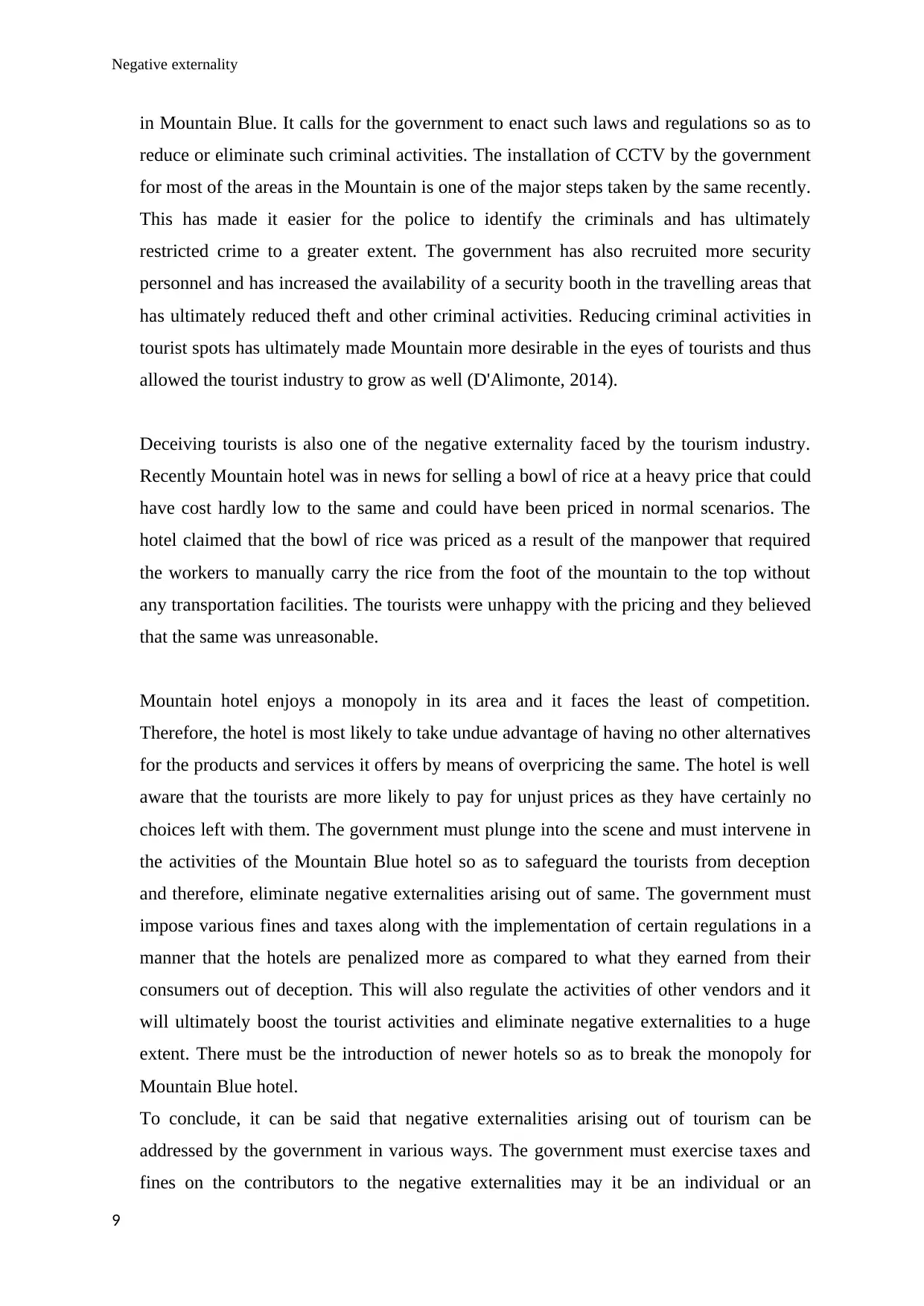
Negative externality
in Mountain Blue. It calls for the government to enact such laws and regulations so as to
reduce or eliminate such criminal activities. The installation of CCTV by the government
for most of the areas in the Mountain is one of the major steps taken by the same recently.
This has made it easier for the police to identify the criminals and has ultimately
restricted crime to a greater extent. The government has also recruited more security
personnel and has increased the availability of a security booth in the travelling areas that
has ultimately reduced theft and other criminal activities. Reducing criminal activities in
tourist spots has ultimately made Mountain more desirable in the eyes of tourists and thus
allowed the tourist industry to grow as well (D'Alimonte, 2014).
Deceiving tourists is also one of the negative externality faced by the tourism industry.
Recently Mountain hotel was in news for selling a bowl of rice at a heavy price that could
have cost hardly low to the same and could have been priced in normal scenarios. The
hotel claimed that the bowl of rice was priced as a result of the manpower that required
the workers to manually carry the rice from the foot of the mountain to the top without
any transportation facilities. The tourists were unhappy with the pricing and they believed
that the same was unreasonable.
Mountain hotel enjoys a monopoly in its area and it faces the least of competition.
Therefore, the hotel is most likely to take undue advantage of having no other alternatives
for the products and services it offers by means of overpricing the same. The hotel is well
aware that the tourists are more likely to pay for unjust prices as they have certainly no
choices left with them. The government must plunge into the scene and must intervene in
the activities of the Mountain Blue hotel so as to safeguard the tourists from deception
and therefore, eliminate negative externalities arising out of same. The government must
impose various fines and taxes along with the implementation of certain regulations in a
manner that the hotels are penalized more as compared to what they earned from their
consumers out of deception. This will also regulate the activities of other vendors and it
will ultimately boost the tourist activities and eliminate negative externalities to a huge
extent. There must be the introduction of newer hotels so as to break the monopoly for
Mountain Blue hotel.
To conclude, it can be said that negative externalities arising out of tourism can be
addressed by the government in various ways. The government must exercise taxes and
fines on the contributors to the negative externalities may it be an individual or an
9
in Mountain Blue. It calls for the government to enact such laws and regulations so as to
reduce or eliminate such criminal activities. The installation of CCTV by the government
for most of the areas in the Mountain is one of the major steps taken by the same recently.
This has made it easier for the police to identify the criminals and has ultimately
restricted crime to a greater extent. The government has also recruited more security
personnel and has increased the availability of a security booth in the travelling areas that
has ultimately reduced theft and other criminal activities. Reducing criminal activities in
tourist spots has ultimately made Mountain more desirable in the eyes of tourists and thus
allowed the tourist industry to grow as well (D'Alimonte, 2014).
Deceiving tourists is also one of the negative externality faced by the tourism industry.
Recently Mountain hotel was in news for selling a bowl of rice at a heavy price that could
have cost hardly low to the same and could have been priced in normal scenarios. The
hotel claimed that the bowl of rice was priced as a result of the manpower that required
the workers to manually carry the rice from the foot of the mountain to the top without
any transportation facilities. The tourists were unhappy with the pricing and they believed
that the same was unreasonable.
Mountain hotel enjoys a monopoly in its area and it faces the least of competition.
Therefore, the hotel is most likely to take undue advantage of having no other alternatives
for the products and services it offers by means of overpricing the same. The hotel is well
aware that the tourists are more likely to pay for unjust prices as they have certainly no
choices left with them. The government must plunge into the scene and must intervene in
the activities of the Mountain Blue hotel so as to safeguard the tourists from deception
and therefore, eliminate negative externalities arising out of same. The government must
impose various fines and taxes along with the implementation of certain regulations in a
manner that the hotels are penalized more as compared to what they earned from their
consumers out of deception. This will also regulate the activities of other vendors and it
will ultimately boost the tourist activities and eliminate negative externalities to a huge
extent. There must be the introduction of newer hotels so as to break the monopoly for
Mountain Blue hotel.
To conclude, it can be said that negative externalities arising out of tourism can be
addressed by the government in various ways. The government must exercise taxes and
fines on the contributors to the negative externalities may it be an individual or an
9
⊘ This is a preview!⊘
Do you want full access?
Subscribe today to unlock all pages.

Trusted by 1+ million students worldwide
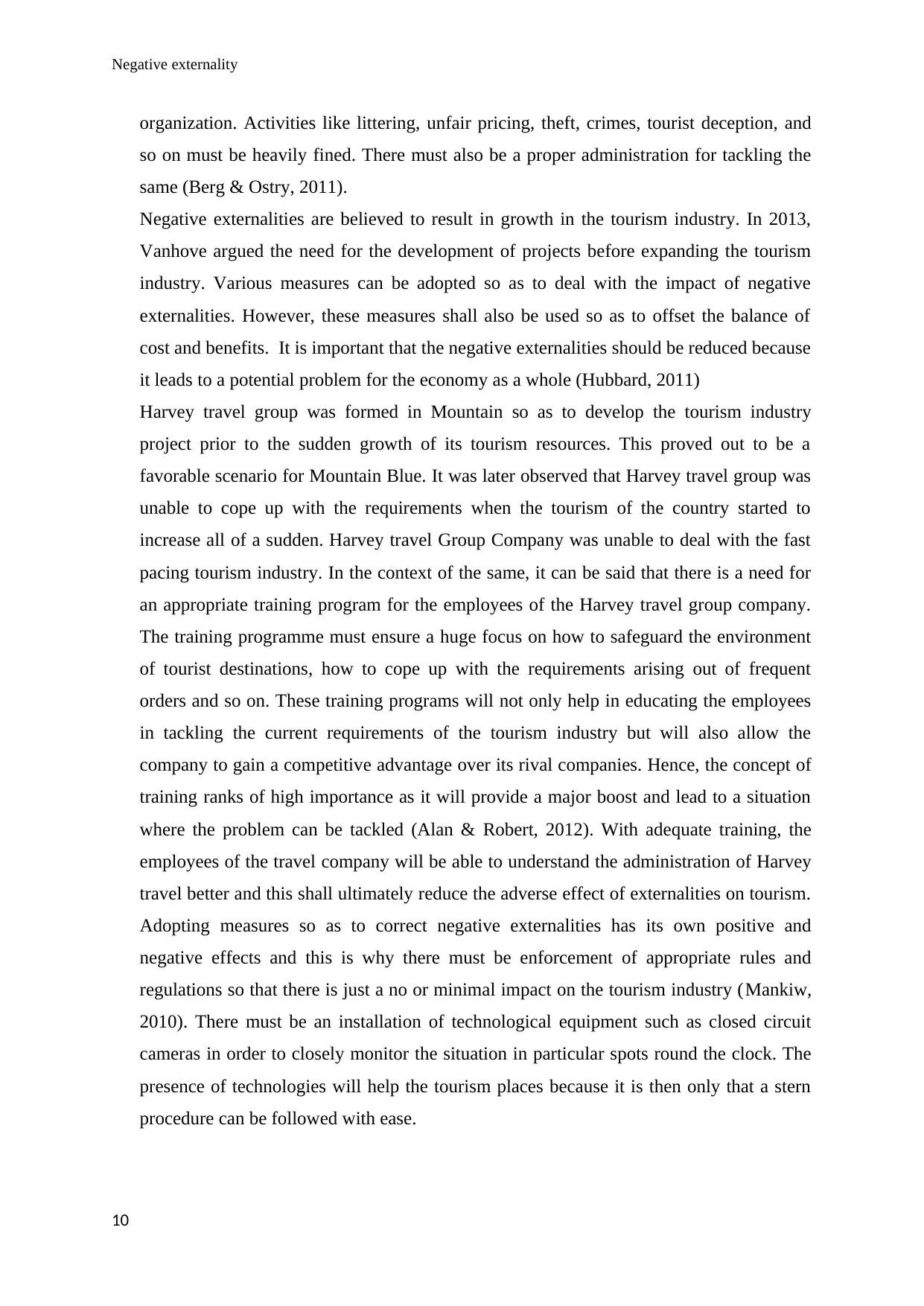
Negative externality
organization. Activities like littering, unfair pricing, theft, crimes, tourist deception, and
so on must be heavily fined. There must also be a proper administration for tackling the
same (Berg & Ostry, 2011).
Negative externalities are believed to result in growth in the tourism industry. In 2013,
Vanhove argued the need for the development of projects before expanding the tourism
industry. Various measures can be adopted so as to deal with the impact of negative
externalities. However, these measures shall also be used so as to offset the balance of
cost and benefits. It is important that the negative externalities should be reduced because
it leads to a potential problem for the economy as a whole (Hubbard, 2011)
Harvey travel group was formed in Mountain so as to develop the tourism industry
project prior to the sudden growth of its tourism resources. This proved out to be a
favorable scenario for Mountain Blue. It was later observed that Harvey travel group was
unable to cope up with the requirements when the tourism of the country started to
increase all of a sudden. Harvey travel Group Company was unable to deal with the fast
pacing tourism industry. In the context of the same, it can be said that there is a need for
an appropriate training program for the employees of the Harvey travel group company.
The training programme must ensure a huge focus on how to safeguard the environment
of tourist destinations, how to cope up with the requirements arising out of frequent
orders and so on. These training programs will not only help in educating the employees
in tackling the current requirements of the tourism industry but will also allow the
company to gain a competitive advantage over its rival companies. Hence, the concept of
training ranks of high importance as it will provide a major boost and lead to a situation
where the problem can be tackled (Alan & Robert, 2012). With adequate training, the
employees of the travel company will be able to understand the administration of Harvey
travel better and this shall ultimately reduce the adverse effect of externalities on tourism.
Adopting measures so as to correct negative externalities has its own positive and
negative effects and this is why there must be enforcement of appropriate rules and
regulations so that there is just a no or minimal impact on the tourism industry (Mankiw,
2010). There must be an installation of technological equipment such as closed circuit
cameras in order to closely monitor the situation in particular spots round the clock. The
presence of technologies will help the tourism places because it is then only that a stern
procedure can be followed with ease.
10
organization. Activities like littering, unfair pricing, theft, crimes, tourist deception, and
so on must be heavily fined. There must also be a proper administration for tackling the
same (Berg & Ostry, 2011).
Negative externalities are believed to result in growth in the tourism industry. In 2013,
Vanhove argued the need for the development of projects before expanding the tourism
industry. Various measures can be adopted so as to deal with the impact of negative
externalities. However, these measures shall also be used so as to offset the balance of
cost and benefits. It is important that the negative externalities should be reduced because
it leads to a potential problem for the economy as a whole (Hubbard, 2011)
Harvey travel group was formed in Mountain so as to develop the tourism industry
project prior to the sudden growth of its tourism resources. This proved out to be a
favorable scenario for Mountain Blue. It was later observed that Harvey travel group was
unable to cope up with the requirements when the tourism of the country started to
increase all of a sudden. Harvey travel Group Company was unable to deal with the fast
pacing tourism industry. In the context of the same, it can be said that there is a need for
an appropriate training program for the employees of the Harvey travel group company.
The training programme must ensure a huge focus on how to safeguard the environment
of tourist destinations, how to cope up with the requirements arising out of frequent
orders and so on. These training programs will not only help in educating the employees
in tackling the current requirements of the tourism industry but will also allow the
company to gain a competitive advantage over its rival companies. Hence, the concept of
training ranks of high importance as it will provide a major boost and lead to a situation
where the problem can be tackled (Alan & Robert, 2012). With adequate training, the
employees of the travel company will be able to understand the administration of Harvey
travel better and this shall ultimately reduce the adverse effect of externalities on tourism.
Adopting measures so as to correct negative externalities has its own positive and
negative effects and this is why there must be enforcement of appropriate rules and
regulations so that there is just a no or minimal impact on the tourism industry (Mankiw,
2010). There must be an installation of technological equipment such as closed circuit
cameras in order to closely monitor the situation in particular spots round the clock. The
presence of technologies will help the tourism places because it is then only that a stern
procedure can be followed with ease.
10
Paraphrase This Document
Need a fresh take? Get an instant paraphrase of this document with our AI Paraphraser
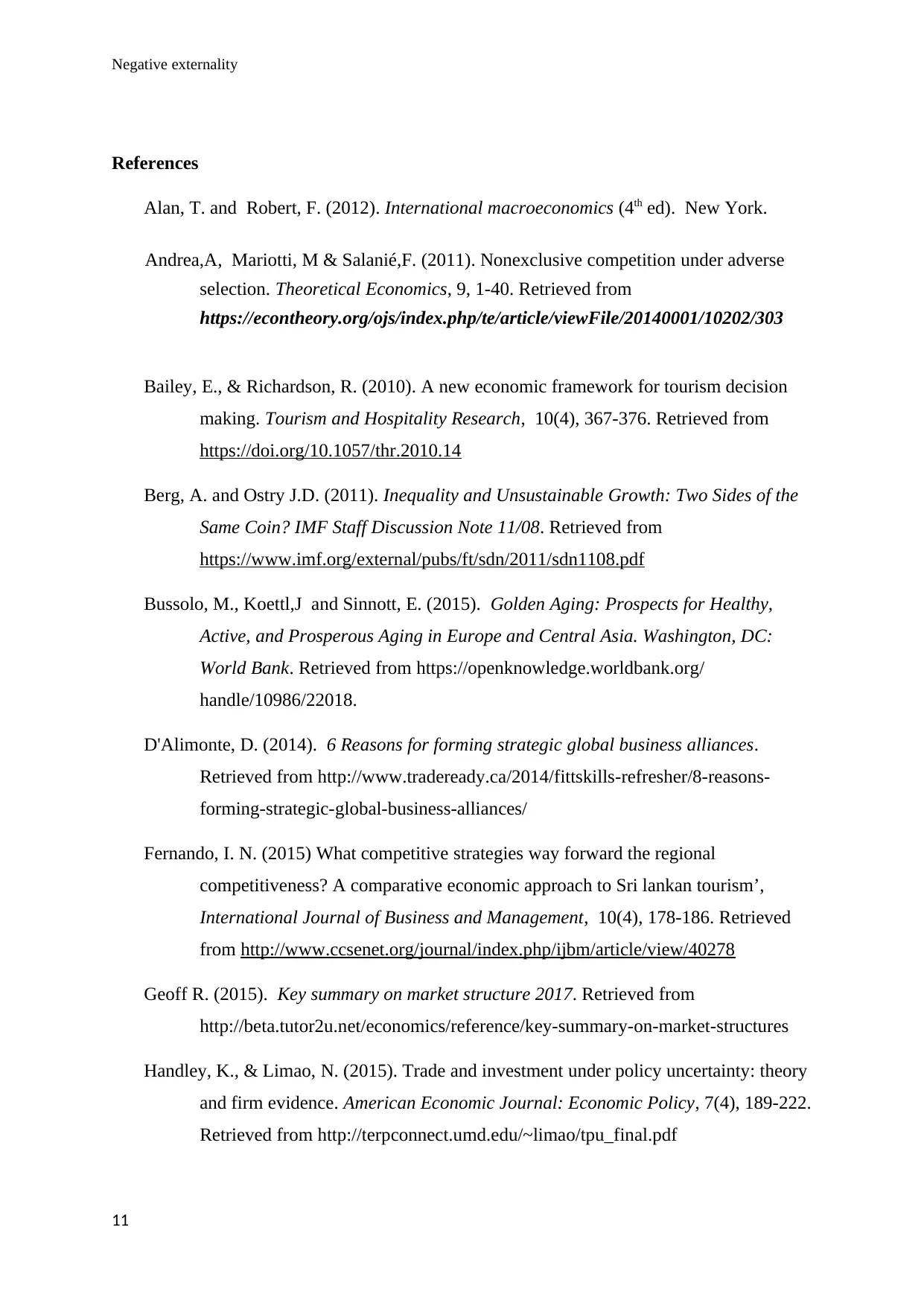
Negative externality
References
Alan, T. and Robert, F. (2012). International macroeconomics (4th ed). New York.
Andrea,A, Mariotti, M & Salanié,F. (2011). Nonexclusive competition under adverse
selection. Theoretical Economics, 9, 1-40. Retrieved from
https://econtheory.org/ojs/index.php/te/article/viewFile/20140001/10202/303
Bailey, E., & Richardson, R. (2010). A new economic framework for tourism decision
making. Tourism and Hospitality Research, 10(4), 367-376. Retrieved from
https://doi.org/10.1057/thr.2010.14
Berg, A. and Ostry J.D. (2011). Inequality and Unsustainable Growth: Two Sides of the
Same Coin? IMF Staff Discussion Note 11/08. Retrieved from
https://www.imf.org/external/pubs/ft/sdn/2011/sdn1108.pdf
Bussolo, M., Koettl,J and Sinnott, E. (2015). Golden Aging: Prospects for Healthy,
Active, and Prosperous Aging in Europe and Central Asia. Washington, DC:
World Bank. Retrieved from https://openknowledge.worldbank.org/
handle/10986/22018.
D'Alimonte, D. (2014). 6 Reasons for forming strategic global business alliances.
Retrieved from http://www.tradeready.ca/2014/fittskills-refresher/8-reasons-
forming-strategic-global-business-alliances/
Fernando, I. N. (2015) What competitive strategies way forward the regional
competitiveness? A comparative economic approach to Sri lankan tourism’,
International Journal of Business and Management, 10(4), 178-186. Retrieved
from http://www.ccsenet.org/journal/index.php/ijbm/article/view/40278
Geoff R. (2015). Key summary on market structure 2017. Retrieved from
http://beta.tutor2u.net/economics/reference/key-summary-on-market-structures
Handley, K., & Limao, N. (2015). Trade and investment under policy uncertainty: theory
and firm evidence. American Economic Journal: Economic Policy, 7(4), 189-222.
Retrieved from http://terpconnect.umd.edu/~limao/tpu_final.pdf
11
References
Alan, T. and Robert, F. (2012). International macroeconomics (4th ed). New York.
Andrea,A, Mariotti, M & Salanié,F. (2011). Nonexclusive competition under adverse
selection. Theoretical Economics, 9, 1-40. Retrieved from
https://econtheory.org/ojs/index.php/te/article/viewFile/20140001/10202/303
Bailey, E., & Richardson, R. (2010). A new economic framework for tourism decision
making. Tourism and Hospitality Research, 10(4), 367-376. Retrieved from
https://doi.org/10.1057/thr.2010.14
Berg, A. and Ostry J.D. (2011). Inequality and Unsustainable Growth: Two Sides of the
Same Coin? IMF Staff Discussion Note 11/08. Retrieved from
https://www.imf.org/external/pubs/ft/sdn/2011/sdn1108.pdf
Bussolo, M., Koettl,J and Sinnott, E. (2015). Golden Aging: Prospects for Healthy,
Active, and Prosperous Aging in Europe and Central Asia. Washington, DC:
World Bank. Retrieved from https://openknowledge.worldbank.org/
handle/10986/22018.
D'Alimonte, D. (2014). 6 Reasons for forming strategic global business alliances.
Retrieved from http://www.tradeready.ca/2014/fittskills-refresher/8-reasons-
forming-strategic-global-business-alliances/
Fernando, I. N. (2015) What competitive strategies way forward the regional
competitiveness? A comparative economic approach to Sri lankan tourism’,
International Journal of Business and Management, 10(4), 178-186. Retrieved
from http://www.ccsenet.org/journal/index.php/ijbm/article/view/40278
Geoff R. (2015). Key summary on market structure 2017. Retrieved from
http://beta.tutor2u.net/economics/reference/key-summary-on-market-structures
Handley, K., & Limao, N. (2015). Trade and investment under policy uncertainty: theory
and firm evidence. American Economic Journal: Economic Policy, 7(4), 189-222.
Retrieved from http://terpconnect.umd.edu/~limao/tpu_final.pdf
11
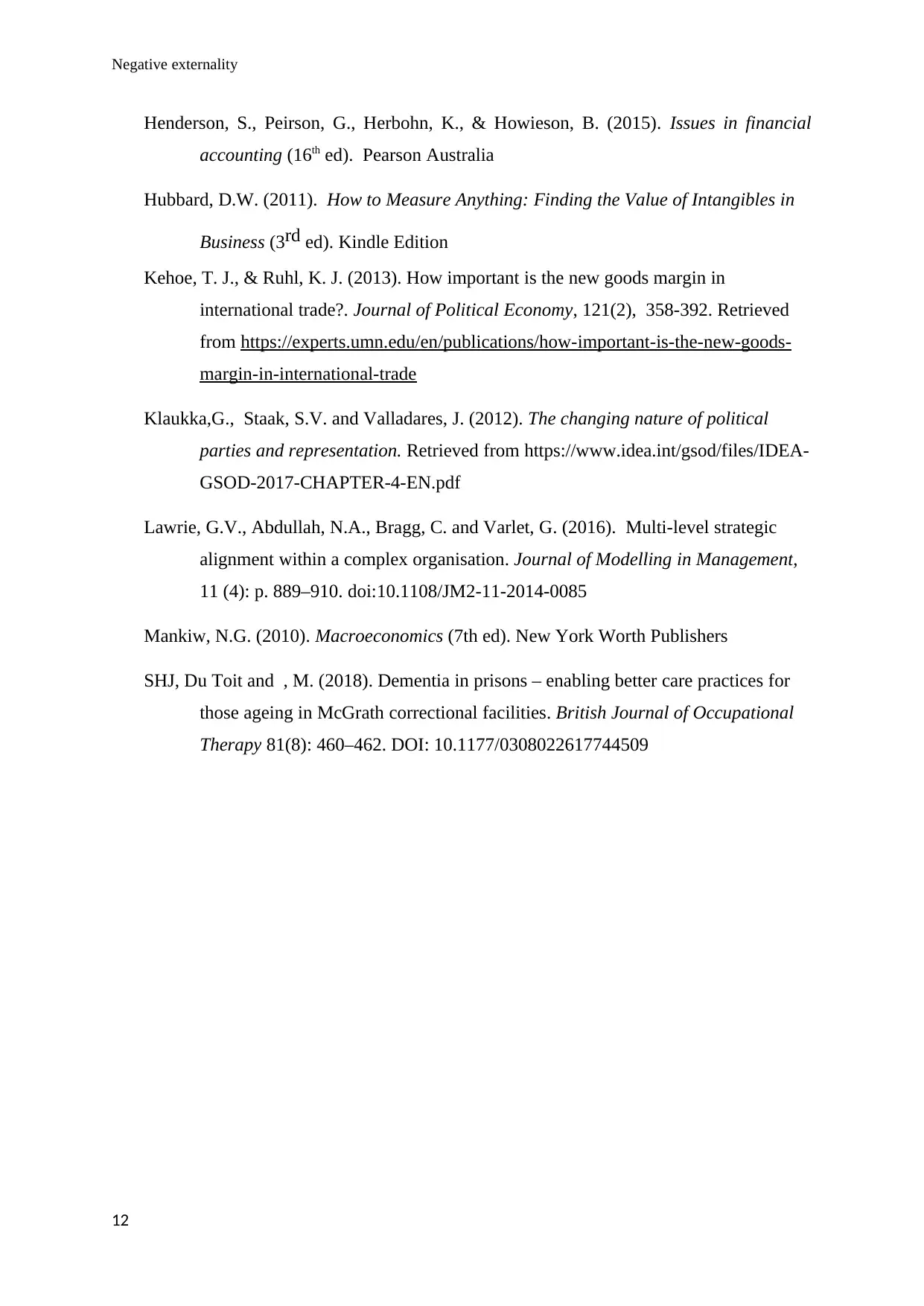
Negative externality
Henderson, S., Peirson, G., Herbohn, K., & Howieson, B. (2015). Issues in financial
accounting (16th ed). Pearson Australia
Hubbard, D.W. (2011). How to Measure Anything: Finding the Value of Intangibles in
Business (3rd ed). Kindle Edition
Kehoe, T. J., & Ruhl, K. J. (2013). How important is the new goods margin in
international trade?. Journal of Political Economy, 121(2), 358-392. Retrieved
from https://experts.umn.edu/en/publications/how-important-is-the-new-goods-
margin-in-international-trade
Klaukka,G., Staak, S.V. and Valladares, J. (2012). The changing nature of political
parties and representation. Retrieved from https://www.idea.int/gsod/files/IDEA-
GSOD-2017-CHAPTER-4-EN.pdf
Lawrie, G.V., Abdullah, N.A., Bragg, C. and Varlet, G. (2016). Multi-level strategic
alignment within a complex organisation. Journal of Modelling in Management,
11 (4): p. 889–910. doi:10.1108/JM2-11-2014-0085
Mankiw, N.G. (2010). Macroeconomics (7th ed). New York Worth Publishers
SHJ, Du Toit and , M. (2018). Dementia in prisons – enabling better care practices for
those ageing in McGrath correctional facilities. British Journal of Occupational
Therapy 81(8): 460–462. DOI: 10.1177/0308022617744509
12
Henderson, S., Peirson, G., Herbohn, K., & Howieson, B. (2015). Issues in financial
accounting (16th ed). Pearson Australia
Hubbard, D.W. (2011). How to Measure Anything: Finding the Value of Intangibles in
Business (3rd ed). Kindle Edition
Kehoe, T. J., & Ruhl, K. J. (2013). How important is the new goods margin in
international trade?. Journal of Political Economy, 121(2), 358-392. Retrieved
from https://experts.umn.edu/en/publications/how-important-is-the-new-goods-
margin-in-international-trade
Klaukka,G., Staak, S.V. and Valladares, J. (2012). The changing nature of political
parties and representation. Retrieved from https://www.idea.int/gsod/files/IDEA-
GSOD-2017-CHAPTER-4-EN.pdf
Lawrie, G.V., Abdullah, N.A., Bragg, C. and Varlet, G. (2016). Multi-level strategic
alignment within a complex organisation. Journal of Modelling in Management,
11 (4): p. 889–910. doi:10.1108/JM2-11-2014-0085
Mankiw, N.G. (2010). Macroeconomics (7th ed). New York Worth Publishers
SHJ, Du Toit and , M. (2018). Dementia in prisons – enabling better care practices for
those ageing in McGrath correctional facilities. British Journal of Occupational
Therapy 81(8): 460–462. DOI: 10.1177/0308022617744509
12
⊘ This is a preview!⊘
Do you want full access?
Subscribe today to unlock all pages.

Trusted by 1+ million students worldwide
1 out of 12
Related Documents
Your All-in-One AI-Powered Toolkit for Academic Success.
+13062052269
info@desklib.com
Available 24*7 on WhatsApp / Email
![[object Object]](/_next/static/media/star-bottom.7253800d.svg)
Unlock your academic potential
Copyright © 2020–2025 A2Z Services. All Rights Reserved. Developed and managed by ZUCOL.





